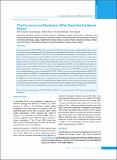Please use this identifier to cite or link to this item:
https://hdl.handle.net/20.500.14356/1186Full metadata record
| DC Field | Value | Language |
|---|---|---|
| dc.contributor.author | Paudel, Shishir | - |
| dc.contributor.author | Dangal, Ganesh | - |
| dc.contributor.author | Chalise, Anisha | - |
| dc.contributor.author | Bhandari, Tulsi Ram | - |
| dc.contributor.author | Dangal, Ojash | - |
| dc.date.accessioned | 2023-05-02T07:43:35Z | - |
| dc.date.available | 2023-05-02T07:43:35Z | - |
| dc.date.issued | 2020 | - |
| dc.identifier.citation | PaudelS., DangalG., ChaliseA., BhandariT. R., & DangalO. (2020). The Coronavirus Pandemic: What Does the Evidence Show?. Journal of Nepal Health Research Council, 18(1), 1-9. https://doi.org/10.33314/jnhrc.v18i1.2596 | en_US |
| dc.identifier.issn | JNHRC Print ISSN: 1727-5482; Online ISSN: 1999-6217 | - |
| dc.identifier.uri | http://103.69.126.140:8080/handle/20.500.14356/1186 | - |
| dc.description | Review Article | en_US |
| dc.description.abstract | Abstract Coronavirus disease 2019 (COVID-19) is a newly emerged disease that has become a global public health concern as it rapidly spread around the world. The etiologic agent responsible for this disease has been named as severe acute respiratory syndrome coronavirus-2 (SARS-CoV-2) by the International Committee on Taxonomy of Viruses as it shows similar genomic features to that of SARS-CoV which caused a pandemic in 2002. This disease first appeared in Hubei province of China and it follows human-to-human transmission but the path this virus took to set up human infection remains a mystery. By 17 April 2020, globally there have been 2,074,529 confirmed cases with 139,378 deaths because of COVID-19. SARS-CoV-2 shows several similarities with SARS?CoV, and Middle East Respiratory Syndrome Coronavirus (MERS-CoV) with its clinical presentations. This can vary from asymptomatic infection to severe disease and mortality. Real-time reverse-transcription polymerase chain reaction (rRT-PCR) screening is considered as the standard laboratory test for the diagnosis of COVID-19. There is no proven antiviral agent against SARS-CoV-2 so the treatment for COVID-19 is symptomatic, aiming for the management of the symptoms and prevention of the complications. The outbreak of COVID-19 has led to the implementation of extraordinary public health measures throughout the world. Numerous antiviral compounds used to treat other infections are being clinically researched to find possible treatment. Similarly, the traditional public health outbreak response strategy of isolation, quarantine, social distancing and community containment has been implemented in multiple countries and has played an important role in the prevention of new outbreaks. This review aims to enhance our understanding of COVID 19. Keywords: Coronavirus disease 2019; COVID-19; SARS-CoV-2; novel coronavirus 2019; severe acute respiratory syndrome-2 | en_US |
| dc.language.iso | en | en_US |
| dc.publisher | Nepal Health Research Council | en_US |
| dc.relation.ispartofseries | Jan-Mar 2020;2596 | - |
| dc.subject | Coronavirus disease 2019 | en_US |
| dc.subject | COVID-19 | en_US |
| dc.subject | SARS-CoV-2 | en_US |
| dc.subject | Novel coronavirus 2019 | en_US |
| dc.subject | Severe acute respiratory syndrome-2 | en_US |
| dc.title | The Coronavirus Pandemic: What Does the Evidence Show? | en_US |
| dc.type | Journal Article | en_US |
| local.journal.category | Review Article | - |
| Appears in Collections: | Vol. 18 No. 1 (2020): Vol. 18 No. 1 Issue 46 Jan-Mar 2020 | |
Files in This Item:
| File | Description | Size | Format | |
|---|---|---|---|---|
| 2596-Manuscript-14297-1-10-20200420.pdf | Fulltext Article. | 455.02 kB | Adobe PDF |  View/Open |
Items in DSpace are protected by copyright, with all rights reserved, unless otherwise indicated.
